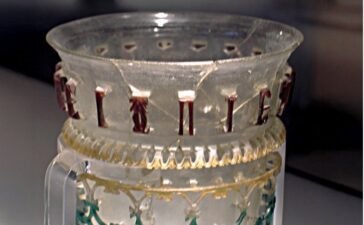Jan Bartek – AncientPages.com – The cliffs of Athribis may conceal a former sanctuary, as suggested by recent archaeological findings. In the small Egyptian village near Sohag, approximately 200 kilometers north of Luxor, researchers have discovered a temple entrance that supports this theory. The structure known as the pylon features two towers flanking a central entrance.
Background: Temple of Ptolemy XII as seen from the north. Credit: Athribis Project. Front: Relief of the goddess Repit (room E4) in the Athribis temple in Sohag, Egypt. Credit: Christian Leitz – Athribis Projekt – CC BY-SA 4.0. Image compilation: AncientPages.com
According to Professor Christian Leitz and excavation manager Marcus Müller from the Institute for Ancient Near Eastern Civilizations (IANES) at the University of Tübingen, it is believed that an entrance to a rock-cut temple lies beneath untouched rubble behind these structures.
Since 2022, researchers from Tübingen have collaborated with Mohamed Abdelbadia from the Egyptian Antiquities Authority and an Egyptian team in Athribis to unearth a significant stone temple. Excavations in this area have been ongoing since 2012 with the aim of revealing an ancient temple district constructed between 144 B.C. and 138 C.E.
The monumental temple complex, originally 51 meters wide with entrance towers each standing 18 meters tall, now has only about 5 meters remaining due to quarrying activities. A coin found at the site dates this stone removal to around the year 752. Recent excavations in the northern tower and entrance gate have uncovered reliefs depicting a king offering sacrifices to Repit, a lion-headed goddess, and her son Kolanthes.
The north tower of the temple with the newly discovered chamber. Credit: Marcus Müller, Athribis Project
Historically, this site was part of Hut-Repyt town, located approximately 200 kilometers north of Luxor. The Greeks later renamed it Athribis as its significance grew. Newly discovered hieroglyphic inscriptions attribute the decoration and likely construction of the pylon to Ptolemy VIII from the 2nd century B.C.
Room 1 after excavation. Credit: Athribis Project
In an unexpected discovery within the north tower of the pylon, archaeologists found a previously unknown chamber by removing a massive ceiling block using innovative methods like air cushions and wooden scaffolding. Measuring about six by almost three meters, this chamber served as storage for temple utensils and amphorae.
A corridor connects it through the pylon for external access; its entrance is adorned with reliefs featuring Repit and fertility god Min alongside rare depictions of decans—stars represented with falcon and ibis heads that aided nighttime timekeeping.
See also: More Archaeology News
Future excavations planned for November 2024 aim to uncover traces of a presumed temple behind this structure. According to Leitz, finely smoothed limestone blocks on a vertically cut rock façade might belong to a rock sanctuary. The more than four-meter-high find features decorations typical of temples’ upper ends—such as cobra friezes—suggesting there could be another door concealed behind these elements.
More information about the Athribis project can be found here
Written by Jan Bartek – AncientPages.com Staff Writer









